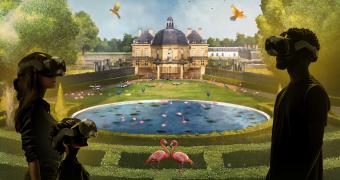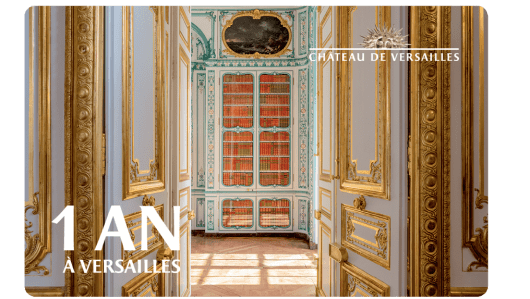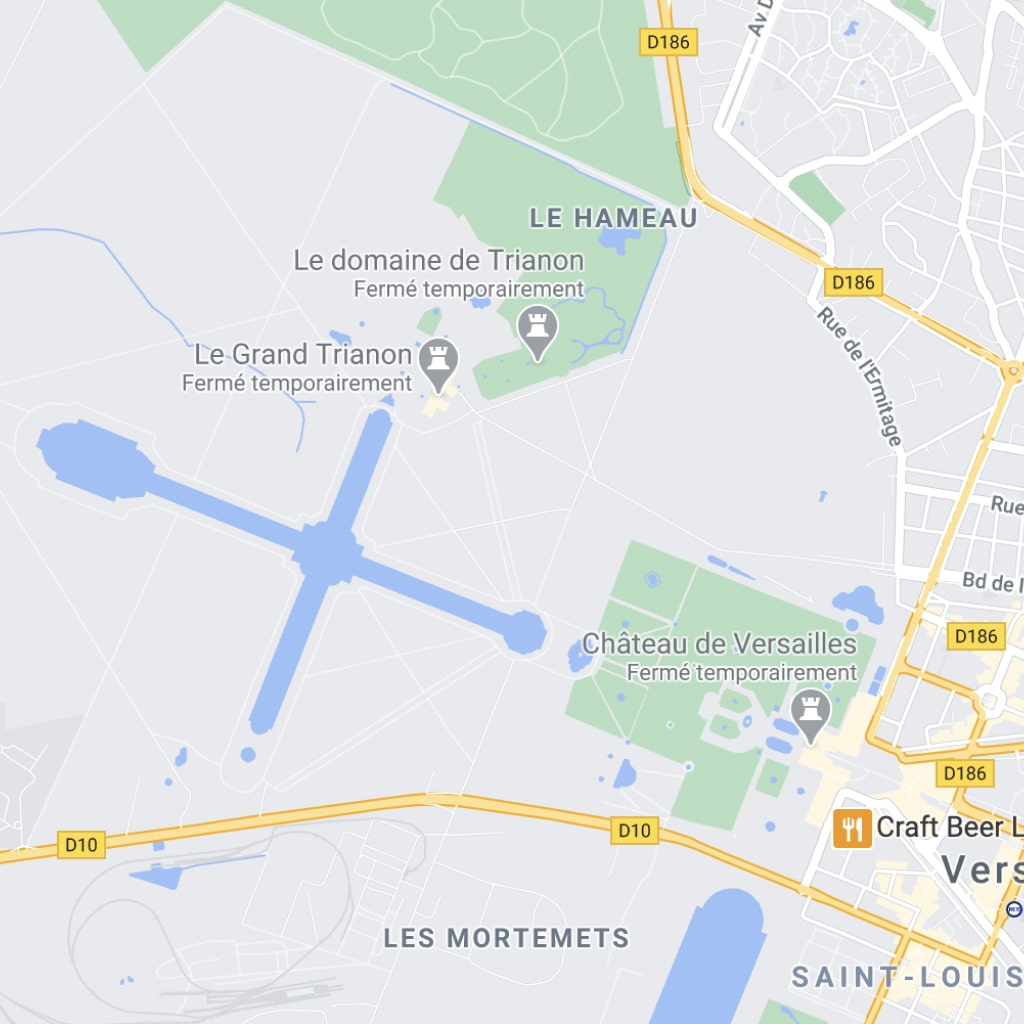Today, as in the time of Louis XIV, Versailles is a place of contemporary creation. Every year, an internationally renowned artist is invited to produce works that are displayed for a season in the Palace and Gardens. In addition to this temporary exhibition, some works by contemporary artists are now an integral part of the Estate.
Individual, People with disabilities Contemporary Art in Versailles
PRACTICAL INFORMATION
Duration of visit
Variable, according to the exhibition.
View detailed times
Avoid the crowd
Recommended seasons
High season, from April to October
Sites
The Palace and gardens
Ticket
1 or 2-Day Passport / Palace Ticket
Free admission (documentary proof required): under-18s, under 26 years old residing in the EU, disabled persons, job-seekers…
See the conditions for free admission
AFree admission to the gardens for all except on days of Musical Fountains Show or Musical Gardens (most Tuesdays, Fridays and weekends between the end of March and the end of October. In this case, there are several possibilities:
- If you benefit from free admission to the Palace and the Trianon Estate, or you do not wish to visit them:
buy a ticket for the Musical Fountains Show or Musical Gardens (access only to the gardens and event of the day). - If you are not entitled to free admission to the Palace and the Trianon Estate, and you do wish to visit them:
buy a 1 or 2-Day Passport • (complete access to the Estate: gardens and event of the day, Palace of Versailles, Trianon Palaces and the Estate of Marie Antoinette).
An annual exhibition and permanent works
A venue for contemporary creation in the seventeenth and eighteenth centuries, the Palace of Versailles has restored its links with contemporary creativity since 2008. Every year, a contemporary artist of international renown is invited to produce works that resonate with the history of Versailles and its exceptional sites, both in the Palace and the gardens. The artists invited over the past few years have been Jeff Koons in 2008, Xavier Veilhan in 2009, Takashi Murakami in 2010, Bernar Venet in 2011, Joana Vasconcelos in 2012, Giuseppe Penone in 2013, Lee Ufan in 2014, Anish Kapoor in 2015 and Olafur Eliasson in 2016. Exhibitions usually take place in high season between March and October.
At the same time, the Palace of Versailles regularly adds permanent works of contemporary art to its holdings during the course of interior and exterior refurbishment.
The Dufour Pavilion
After the first security check at the Main Gate:
- If you benefit from free admission or you already have your printed ticket, go straight to entrance A with your ticket or document.
- If you are not entitled to free admission and have not reserved your ticket in advance, go the main ticket office on the left side of the Ministers’ Wing South, then head for entrance A.
Entrance A is located in the Dufour Pavilion, which takes its name from the architect who finally built it between 1814 and 1817 to a design by Gabriel in 1770. To receive individual visitors better (groups enter via the Gabriel Pavilion), the Dufour Pavilion was refurbished between 2011 and 2016 by architect Dominique Perrault and designer Gaëlle Lauriot-Prévost. A great golden wave accompanies visitors as they pass through, illuminated by the numerous chandeliers and their reflectors made of golden blades. On the floor, a parquet of tangled metal slats echoes the complex wooden floors of the Palace.
In the basement of the Dufour Pavilion, which you may see before starting your visit of the Palace if you require the cloakroom or the toilets, and which you will necessarily walk through at the very end of your visit on leaving the Palace, do not miss the work of Claude Rutault. The dialogue between marble and painting reflects the artist’s concern to compare painted and unpainted surfaces.
The Chandelier over the Gabriel Staircase
After crossing the Royal Courtyard to begin the tour of the State Apartments, you will see the lower part of the Gabriel staircase. This staircase is only accessible to groups, but you can see it again on the first floor, from the Hercules Room, where one of the doors opens onto this staircase.
Since 2013, the Gabriel Staircase has been illuminated by a chandelier created by two contemporary artists, Ronan and Erwan Bouroullec, and made by Swarovski. The chandelier is made up of three cords, each consisting of hundreds of crystal blocks illuminated by LEDs that give out a soft and enveloping light. These long, supple lines form an organic design governed by the laws of gravity that each observer can gauge differently and gradually by climbing the two ramps of the staircase. The use of crystal assures a link with the past given that historically, all the chandeliers of Versailles were made with this material.
Refurbishment of the Water Theatre
Be sure not to miss a visit to the gardens to discover the Water Theatre Grove [42 on the map of the estate] redesigned by Louis Benech and adorned with sculpture fountains by Jean-Michel Othoniel.
Today the question arises of managing the gardens and maintaining them, especially since the storm of 1999 which severely damaged the Estate. While the decision was usually made to opt for a return to the form the garden had under Louis XIV, one of the groves has been the subject of a contemporary redesign. Created between 1671 and 1674, the Water Theatre Grove is one of the richest to have been designed by Le Nôtre in Versailles, hosting a stage and terraces surrounded by complex fountains. After its destruction by Louis XVI, what remained was simplified. In 2011, a competition was launched to give a new lease of life to this abandoned grove. The project chosen, which fell within the scope of the one percent for art programme, is by landscape artist Louis Benech, and visual artist Jean-Michel Othoniel, and invites the visitor to a vision imbued with dance and inaugurated in 2015. Three sculpture fountains in glass beads revive the choreographies written by Raoul Auger Feuillet for Louis XIV. Now the king dances once again – on water – in a grove, one of the spaces set aside for entertainment during his reign.
What is the one percent for art programme?
It is a measure designed to support the creation of contemporary art and raise society’s awareness of it thanks to the variety of institutions concerned (school buildings, police stations, courthouses, etc.). A legislative process institutes the creation of works of contemporary art for each public construction, with the creation being accorded a budget equivalent to 1% of the total budget for the construction excluding tax. Set up in 1951 for schools, the measure was gradually extended to all public buildings and has given rise to the production of more than 12,600 works.
It was within this context that Philippe Cognée was chosen in 2009 to produce a series of paintings during the works in the Grand Commun reserved for the Palace’s administration. Echo consists of forty-four circular paintings – tondi – evoking the world of the Palace through the details of its gardens and its apartments. The painter moves through history, slipping from interior to exterior, and Versailles appears and disappears within the matter of the paint. Placed side by side, they constitute an aerial whole as “light as a bubble” suggesting a constellation and telling stories about this place of memory. The works were exhibited to the public during the works and were the subject of a book published by Éditions Dilecta.
At this point, you can enjoy a well-deserved lunch break or refreshment!
- Several catering services are available throughout the Estate.
- Picnics are not allowed in the gardens of Versailles. Picnics are also permitted in the Park on the Saint Antoine Plain (in the direction of the Trianon from the Palace), and at the Lake of the Swiss Guard (opposite the Orangery, outside the Estate on the town side down Rue de l’Indépendance Américaine or on the Park side via the Sailors’ Gate).
Extend your visit!
- If you still have half a day or time for another visit: go on a voyage of (re)discovery of the Gardens or the Trianon Palaces and the Estate of Marie Antoinette.
- If you only have an hour or two: take the opportunity to visit one of the temporary exhibitions, or visit the Coach Gallery.
tour tips
- To find out the best time to visit the Palace, see the Frequently Asked Questions.
- Caution, please take care to avoid pickpockets inside and outside the Palace.
- In the rooms, photographs without a flash are permitted, but selfie sticks are not allowed.
- Some items (large bags, suitcases, backpacks, umbrellas, strollers, baby carriers with metal frames...) are not allowed in the rooms and can be left at the cloakrooms.
- There are two free Wifi points: in the Main Courtyard and the entrance to the gardens. You can make use of them to download the Gardens of Versailles app.
- Before the Palace... there used to be a mill! The Palace and grounds can be windy and draughty so bring something warm, even in summer.
Make the most of your discoveries
Take a guided visit to learn more and see some rooms that are closed to the public on self-guided tours!
The visit to the Palace, the audioguide in 13 languages can be collected at the start of the Palace tour. Their content is also available through the mobile app.

From March 25
Virtual Reality: The Sun King’s Lost Gardens
For the first time, the Palace of Versailles is opening its doors for an extraordinary virtual reality (VR) journey back in time! Immerse yourself in 1682 and join André Le Nôtre, Louis XIV’s gardener, on a special tour of specific groves of the gardens which are no existing anymore.

Show
Fountains Shows and Musical Gardens
From April 1st to October 31st 2023, enjoy the Musical Gardens and the Great Musical Waters in the gardens and groves opened for the occasion. Every Saturday evening from 10 June to 23 September, Friday 14 July and Tuesday 15 August, discover the Gardens in the evening with the The Night Fountains Show.

The official Palace of Versailles app
The free application of the Palace offers audio tours to accompany your visit to the Estate (Palace, Gardens, Trianon Estate, etc.) as well as an interactive map.
More information
Are you a regular visitor?
The best of Versailles for subscribers! For a whole year, benefit from numerous advantages thanks to the SOLO or DUO cards, and unlimited ticket access from only 65€.
Choose your subscription



